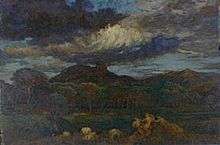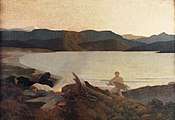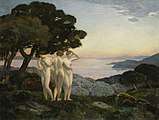Émile-René Ménard
Émile-René Ménard (1862–1930) was a French painter born in Paris.[1] From early childhood he was immersed in an artistic environment: Corot, Millet and the Barbizon painters frequented his family home, familiarizing him thus with both landscape and antique subjects.



Biography
Ménard studied at the Académie Julian from 1880 after having been a student of Baudry, Bouguereau, and Henri Lehmann. He participated in the Salon of the Secession in Munich, and the Salon de la Libre Esthétique in Brussels during 1897. Several personal exhibitions were also devoted to him at the Georges Small Gallery. In 1904, he was appointed professor at the Académie de la Grande Chaumière,[2] and in that year welcomed the rising young Russian painter Boris Kustodiev, age 26, in his art studio. In 1921, he exhibited in the Twelfth Salon along with Henri Martin and Edmond Aman-Jean. Galleries in Buffalo, New York and Boston, Massachusetts exposed Ménard and his art to the United States. However, the numerous commissions that Ménard received from the French government crowned his career; for example, the cycle for the Hautes Etudes à la Sorbonne, the Faculté de Droit, and the fresco Atoms for the Chemistry institute, and finally the Caise des Dépôts in Marseilles.
Ménard's art allies a rigorous, clear classicism with a diffuse and dreamlike brushwork. In 1894, Victor Shoe described Ménard’s work in l'Art et la Vie (Art and Life) as "visions of a pacified, bathed nature, of dawn and of twilight, where the soul seems to immerse itself in the innocence of daybreak, and breathe the divine anointment that comes with the dawn."[3]
 Les errants
Les errants- Spring
_-_%C3%89mile-Ren%C3%A9_M%C3%A9nard.jpg) Vôie Appinne (Paisaje)
Vôie Appinne (Paisaje) The Three Graces, 1923
The Three Graces, 1923
| Wikimedia Commons has media related to Émile-René Ménard. |
References
- Benezit Dictionary of Artists
- (fr)Brugal antiquites
- Jean-David Jumeau-Lafond, Les Peintres de l'Âme: le Symbolisme Idealiste en France, exhibition catalog, Musée d'Ixelles, Brussels, October 15 – December 1999, (Gent: Snoeck-Ducaju & Zoon, and Antwerp: Pandora, c. 1999)